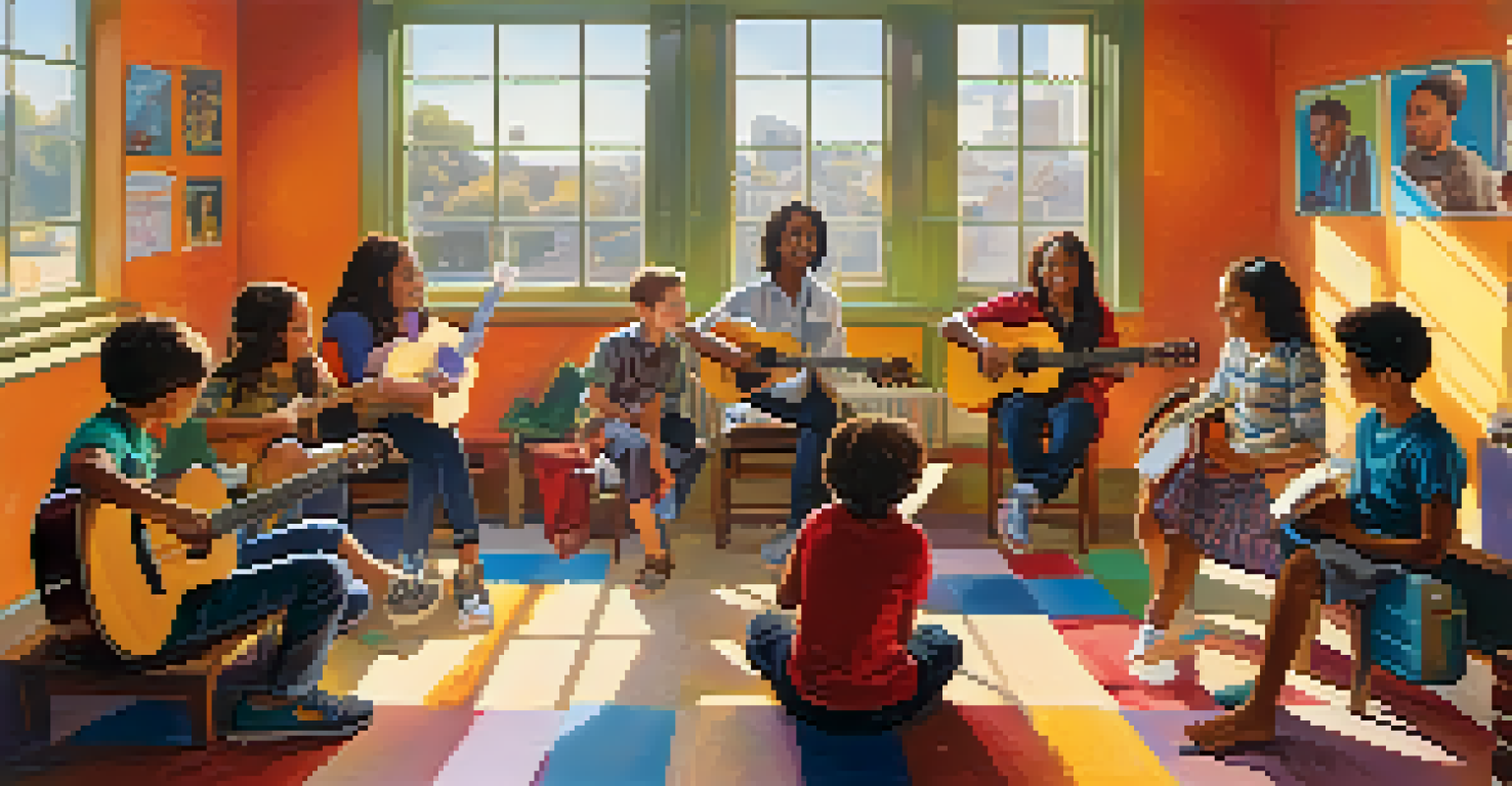Guitar Buying for Kids: What Parents Should Know and Consider

Understanding the Different Types of Guitars
When considering a guitar for your child, it's essential to understand the different types available. Acoustic guitars are often recommended for beginners, as they don't require additional equipment and allow for a natural learning experience. On the other hand, electric guitars offer a different sound and style, which might appeal more to some kids, especially if they're inspired by rock music.
Music can change the world because it can change people.
It's also worth noting that there are variations within these categories, like classical guitars with nylon strings, which are softer and easier on young fingers. As a parent, knowing what each type offers can help you make an informed choice that best suits your child's interests and skills. Think of it as choosing the right tool for the job; the right guitar can spark a love for music.
Ultimately, the goal is to find a guitar that your child feels excited about playing. If they’re drawn to a particular style or sound, it’ll make practicing more enjoyable and less of a chore. So, take some time to explore the options together.
Choosing the Right Size for Comfort and Playability
Size matters when it comes to guitars, especially for kids. A guitar that's too big can be cumbersome and discourage your child from playing. There are various sizes available, including 1/2, 3/4, and full-size guitars, designed to accommodate different age groups and body types.

To find the right fit, have your child hold a few guitars and see how they feel. They should be able to comfortably reach the strings and the fretboard without straining. Remember, the more comfortable they are, the more likely they will practice and improve their skills.
Choose the Right Guitar Type
Understanding the different types of guitars available can help you select an instrument that aligns with your child's interests and makes learning enjoyable.
You might also want to consider the weight of the guitar. A lighter instrument can be easier for younger kids to handle, making it a more enjoyable experience. Ensuring the right size and weight can make all the difference in fostering a love for music.
Setting a Budget: Quality vs. Affordability
Setting a budget is a crucial step when buying a guitar for your child. While it can be tempting to splurge on a high-end model, especially if your child shows great interest, it's important to balance quality with affordability. A decent beginner guitar can be found at a reasonable price without compromising sound quality.
The beautiful thing about learning is that no one can take it away from you.
Think of it this way: investing in a good quality starter guitar can encourage your child to practice and develop their skills. However, if they lose interest after a few months, you don’t want to feel like you’ve wasted a lot of money. It’s wise to look for guitars that offer good value and are well-reviewed by other parents and musicians.
Additionally, consider the possibility of purchasing second-hand instruments. Many kids outgrow their guitars quickly, so you might find a gently used one that’s both budget-friendly and still in great condition. This approach can help you find a quality instrument without breaking the bank.
Accessories to Enhance Your Child's Learning Experience
When buying a guitar, don't forget about the essential accessories that can enhance your child’s learning experience. Things like a tuner, picks, and a comfortable strap can make a significant difference in how they play. A tuner ensures that the guitar sounds good, which is crucial for developing a good ear for music.
A sturdy gig bag or hard case is also important for protecting the guitar when it’s not in use or when traveling to lessons. This can help prevent damage and keep the instrument in good condition, making it a worthwhile investment. Plus, a fun sticker or two can personalize the guitar and make it feel more special to your child.
Size and Comfort Matter
Selecting the right size and weight of the guitar is crucial for your child's comfort and playability, influencing their desire to practice.
By equipping your child with the right accessories, you’re setting them up for success. It shows that you’re supportive of their musical journey and want to make the learning process as enjoyable as possible.
Encouraging Practice Without Pressure
One of the most important things to remember when your child starts learning guitar is to encourage practice without applying too much pressure. Learning an instrument can be challenging, and it's vital to foster a positive environment where your child feels comfortable making mistakes. Celebrate their progress, no matter how small, to keep their motivation high.
You might consider setting aside specific times for practice, making it a fun routine rather than a chore. Perhaps you could play along with them or listen to their favorite songs that feature guitar. This shared experience can help them see practice as an enjoyable activity rather than an obligation.
Remember, every musician progresses at their own pace. Allowing your child to explore their interest in music organically will help them develop a genuine love for playing, which is far more valuable than any pressure to perform perfectly.
Finding the Right Lessons and Resources
Once you’ve secured a guitar, the next step is finding the right lessons or resources for your child. With the rise of online tutorials, there are countless free and paid platforms where kids can learn at their own speed. Websites like YouTube offer a wealth of instructional videos, making it easy to find a style that resonates with your child.
Local music schools or private instructors can also provide personalized guidance, which can be beneficial for young learners. Having a dedicated teacher can help your child stay focused and motivated. Plus, it gives them the chance to ask questions and receive feedback in real time.
Encourage Music Exploration
Promoting a love for music beyond just the guitar can enrich your child's musical journey and inspire creativity in various genres.
Regardless of the method you choose, the key is to ensure that your child feels engaged and excited about learning. Mixing up lessons with fun activities, like playing along with their favorite songs or participating in group classes, can keep their interest alive.
Promoting a Love for Music Beyond the Guitar
Finally, it's important to promote a broader love for music beyond just the guitar. Encourage your child to explore different genres, attend live concerts, or even try out other instruments. This exposure can enrich their musical experience and inspire creativity.
Consider having them listen to various artists or bands with strong guitar elements. Discussing the music can spark interesting conversations and deepen their appreciation for the art form. You might find that they become interested in songwriting or music production as well.

By fostering a well-rounded musical environment, you’re helping your child develop a lifelong passion for music. Remember, the goal is not just to learn an instrument, but to enjoy the journey of musical discovery together.